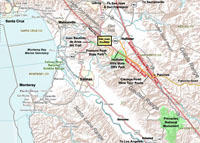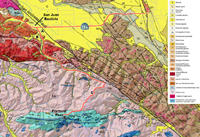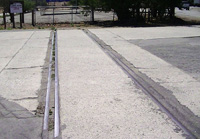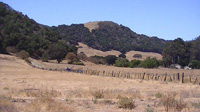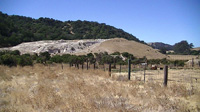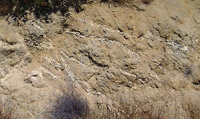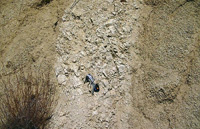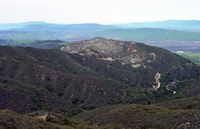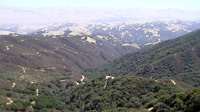
Field Trip to the Fremont Peak State Park, |
| Road-trip to Fremont Peak State Park The park headquarters for Fremont Peak are located on Second Street near the Plaza at San Juan Bautista State Historic Park near downtown San Juan Bautista. From San Juan Bautista, plan a few hours minimum to drive to Fremont Peak, do a mile hike around the mountain peak, and plan to have a picnic is the campground area before you return to San Juan Bautista. Stop A—Intersection of San Juan Canyon Road: Drive south on the Alameda from downtown San Juan Bautista across CA Highway 156 and proceed 0.3 miles to Stop A at the intersection of several roads: Mission Vineyard Road (to the left), Fremont Peak Road (middle road to left) and Salinas Road (straight and to right). Note that the trailhead access road to the Juan Bautista de Anza National Historic Trail—a hiking/horseback riding trail that follows the unpaved historic Old Stage Road between Salinas and San Juan Bautista. Also note the section of railroad tracks in the intersection of the four roads. The San Juan Pacific Railway began operation in 1907 and provided rail service from the San Juan Portland Cement Plant to the Southern Pacific at Chittenden. The San Juan Pacific Railway operated a seven mile line, the Mission Route, starting near to San Juan Bautista. Stop B—Cement Plant mine tailings: Follow San Juan Canyon Road. Be cautious when stopping on the road to examine views. Near the mouth of San Juan Canyon is a large mine tailings pile that was associated with a large cement plant that operated in the lower San Juan Canyon from around 1903 to closure near the end of World War II. The Flint Ranch deposit, a principal source of supply, lies along the tops of the steep hills above San Juan Canyon. In the Gavilan Peak deposits, the limestone shows all degrees of silicification. At several places near the top of the peak, deposits of white, high-grade barite have been found in the limestone and proved large enough to repay mining. The Gavilan limestone is older than the granitic rock and has been changed to highly crystalline marble. The color ranges from dark blue to nearly pure white. The Flint Ranch deposit (abandoned quarry) is located up a side canyon the Pioneer Park (owned by the local Church of Jesus Christ of Latter Day Saints). Stop C—Vaqueros Sandstone outcrops: A brief stop might be possible if no traffic is visible along San Juan Canyon Road. Large, scenic outcrops of Vaqueros Sandstone (or Vaqueros Formation) are visible on the left (north) side of San Juan Canyon about a half mile north of the intersection (Stop A). The Vaqueros Sandstone is Upper Oligocene and Lower Miocene in age. The massive sandstone units of Vaqueros Formation are cliff- and ledge-forming units throughout the Coast Ranges of Central California. The rock formation consists mostly of medium-grained sandstone with zones of shale and conglomerate. Locally abundant marine shell fossils suggest the sediment was deposited in a relatively shallow shelf environment. Vaqueros Sandstone crops out in the Santa Cruz Mountains at Castle Rock State Park and near Gilroy at Chitactac-Adams County Park. It crops out in many locations all the way down the coast to the Santa Barbara region. In the San Juan Bautista region, Vaqueros Sandstone crops out along the Salinas Road, and the form outcrops along Rocks Road and Highway 101 south of the large eucalyptus grove south of the intersection of CA Highway 156 (made famous by the 1957 Alfred Hitchcock movie "Vertigo"). |
 |
| Outcrops of dipping strata of the Vaqueros Sandstone (Oligocene-Miocene) along San Juan Canyon Road | |
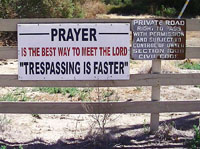 |
|
| A friendly reminder | |
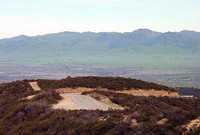 |
|
| San Juan Canyon Road on granite ridge | |
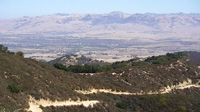 |
|
| Hollister Valley and Quien Sabe Range in distance |
Loop Trail Walk to Fremont Peak The structure of the pendant block that forms the ridge line at Fremont Peak is revealed by the steeply northward dipping bands of layers of marble exposed on the south side of the ridge. Close examination of some of the marble outcrops show that in many places bedding plains are preserved, having escaped complete destruction in metamorphic phase in the formation of the marble and schist. Some of the marble outcrops display stromatolite-like texture (stromatolites are flat-layered, lumpy or mound-shaped accumulations of calcareous sediment associated with the growth of lime-secreting cyanobacteria. The possible occurrence of stromatolites and the apparent lack of shell fossils suggest that the original sediments may be latest Precambrian (Proterozoic) to Cambrian age before shell fossils became abundant in the fossil record. |
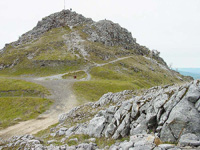 |
| Fremont Peak with outcrops of marble | |
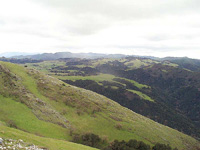 |
|
| Crest of Gavilan Range south of Fremont Peak | |
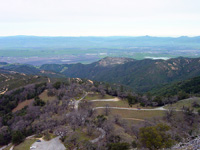 |
|
| Looking northeast over Fremont Peak Campground | |
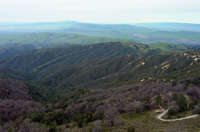 |
|
| Looking north toward Loma Prieta Peak from the peak | |
 |
|
| Marble forms a resistant ridge west of Fremont Peak | |
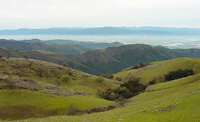 |
|
| Salinas Valley south west of Fremont Peak | |
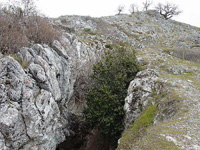 |
|
| Old barite mine on Fremont Peak | |
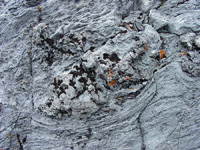 |
|
| Possible stromatolites preserved in marble bedrock |
